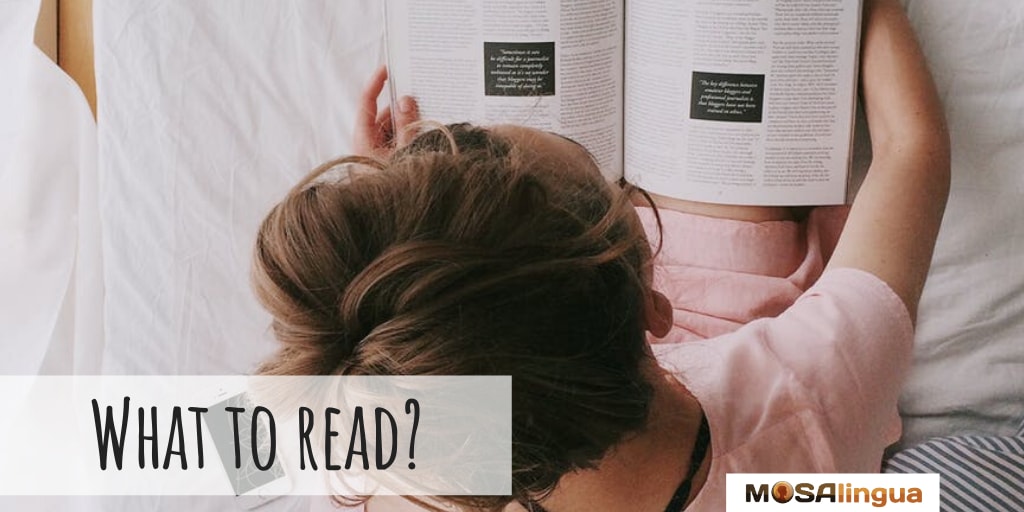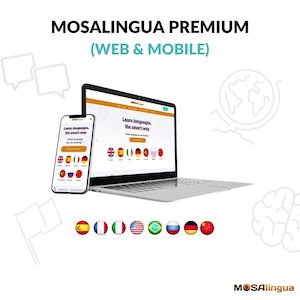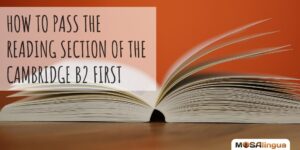Have you ever tried to read in your target language? Especially if you are a beginner, chances are that you found reading difficult or even frustrating… The reason for that is quite straightforward: more often than not, we choose the wrong reading material and we eventually give up. So today our goal is to help you choose what books to read to really improve your language skills! Short stories, novels, online articles, magazines, or comic books – what will you choose?

Why Is Reading in a Foreign Language Hard?
First of all, let’s figure out why reading in a foreign language can be so difficult. When we read in our native language, we are used to understanding nearly every word. As I explained in my video about how many words you need to know to speak a language, a native speaker passively knows around 70,000 words. But as beginners and intermediate learners, we have quite limited vocabularies. So we cannot expect to understand every word of a text in a foreign language. Unfortunately, that’s exactly what we try to do.
The truth is that when you read in your target language you must accept the fact that you won’t understand every single word. It can be hard to come to terms with at first, but you’ll thank yourself later. Luckily, context is always there to help you figure out the big picture of what you’re reading, even when there are word you don’t know.
And whenever you are really stuck, you can always look up a word. That said, don’t stop very often to look up words, because otherwise reading will become a chore. What you can do instead is write the word down and look it up later on. Another tip is to start with short articles and stories. The longer the text, the more likely you are to quit. We often feel the need to finish what we start, and reading an entire novel in a foreign language is not easy!
What Books to Read to Improve Your Language Skills
These are great strategies, but you won’t be able to apply them if you choose a book or an article that is way too difficult for you. When it comes to reading in a foreign language you basically have 2 choices: material written for native speakers and material designed for language learners.
“Authentic texts,” or reading material for native speakers
In this first category, you’ll find a lot of stuff about the various interests and passions you might have. While reading what native speakers read is more appealing and rewarding, I don’t recommend it for beginner and intermediate learners. On the other hand, if you have an advanced level, then you can read pretty much anything you want (as long as you are okay with not knowing all the words and expressions you come across). But since there are probably more beginners and intermediate learners reading this article, if you want to read material written for native speakers…
If you really want to read what native speakers read, there are two kinds of easier reading resources to choose from:
Stories for kids
Lots of learning methods recommend that beginners (even adults) start with kids’ books. But if you try to read stories written for children you’ll realize that they are not the best choice. Why?
- They aren’t interesting for adults,
- and the often contain words and phrases that are not very common or useful.
To give you an example, I have read several books in Romanian without too many issues. But when I tried to read a story for children in Romanian to my son, there were many words I did not know. When I asked my wife to translate, I found out why. These words (like “dandelion,” “ladybug,” and “velvet”) were completely useless to me. So, as an adult, I never felt the need to learn them.
Start learning a new language today

Good news: we can help!
More good news: you can get started for free! Start your free trial now and for the next 15 days, take advantage of the most effective language learning method on the market!
Vocabulary flashcards, videos with subtitles, audiobooks, articles adapted to your level – with MosaLingua Premium (Web & Mobile), you’ll have access to all this and more. Get started right now. It’s free—and risk-free—to try!
Comic books
So what books should you read? Instead, I recommend reading comics and graphic novels. They provide two crutches for you to lean on:
- context (but that’s true for most reading material),
- and pictures.
The images in comic books are usually helpful for figuring out the general meaning of what you read. And you’ll have plenty of choice, because many popular comics have been translated into dozens of languages.
If you’re interested, here’s a list of comics that we recommend for language learners, and where to find them.
Reading designed for language learners
If comics don’t appeal to you, look into the other category I mentioned: books for learners. There are a few different styles to choose from depending on your reading preferences and your level.
Graded readers
A graded book is an “easy reading” resource whose level is adapted to be understood more easily by language learners. So if you are a beginner student, you can read a story or novel that has been simplified specifically for you, but isn’t for kids.
- Pearson and Penguin are two popular publishing houses that offer a pretty decent selection of graded readers in English.
- Check out Clé International for graded readers (livres gradués) in French.
- Santillana ELE and Difusíon both have quite a few graded books and ebooks (lecturas graduadas) for adults who are learning Spanish.
Another good option is the “Short Stories for Beginners” series by our friend Olly Richards. Instead of simplifying existing texts, Olly writes original graded short stories. I have read many graded texts in the past and I must say, they’re useful and enjoyable.
This is one of the many reasons why we decided to put graded texts and articles on our online learning platform included in MosaLingua Premium (Web & Mobile). Plus, with our MosaDiscovery plug-in, whenever you need to look up a word or phrase, all you have to do is click it for a translation. With a second click you can even turn it into a flashcard that you can memorize with the app.
Bilingual books
Another possibility is bilingual books. The text is in your target language on one page and in your mother tongue on the next page. This is very useful because whenever you stumble upon a word or phrase you do not understand, you can always refer to the translation in your native language.
Personally, I prefer bilingual books where you have the two languages side by side. You first make the effort to understand, and then deliberately choose to check the translation on the other side if you need help.
Interlinear books
In the same family of bilingual books, you also have interlinear books, where the translation is just below the original, line by line. This is quite useful, even if I find it a bit distracting. I can be hard to focus on trying to understand the original text without going straight to the translation.
Don’t forget to pick level-appropriate reading material
Of course, whatever books you choose should still match your level. The key is finding something that is neither too easy, nor too difficult for you.
Too easy means that you stay inside your comfort zone and do not make progress very quickly, if at all. Too difficult results in frustration, boredom and giving up.
Choose something in between, based on the theory of comprehensible input. The developer of this theory, American linguist Stephen Krashen, explains that language learners improve their skills when they receive “inputs” that are one step above their current level. That means that you should work with content that is right for your level, but that gradually introduces new ideas (more complex words, grammar concepts, sentence structures, etc.).
Watch: Luca Explains What Books to Read to Maximize Your Results
If you’re not a big reader, maybe you’d prefer to listen to these tips in Luca’s video. He recorded it in English, but feel free to turn on the subtitles (6 languages available) or slow it down. Click the gear icon to do both of those things. Watch it below, or on our YouTube channel.
Don’t forget to subscribe to our YouTube channel while you’re there!
Need more help? Here are some other videos and articles on the same topic:
- If you’re not quite convinced, here are 7 Benefits of Reading in a Foreign Language
- Now that you know what to read, find out How to Read in a Foreign Language
- If you’re learning English, check out these English Books for Learners
- And The Best Books to Improve Your Spanish, French, and German




Comments